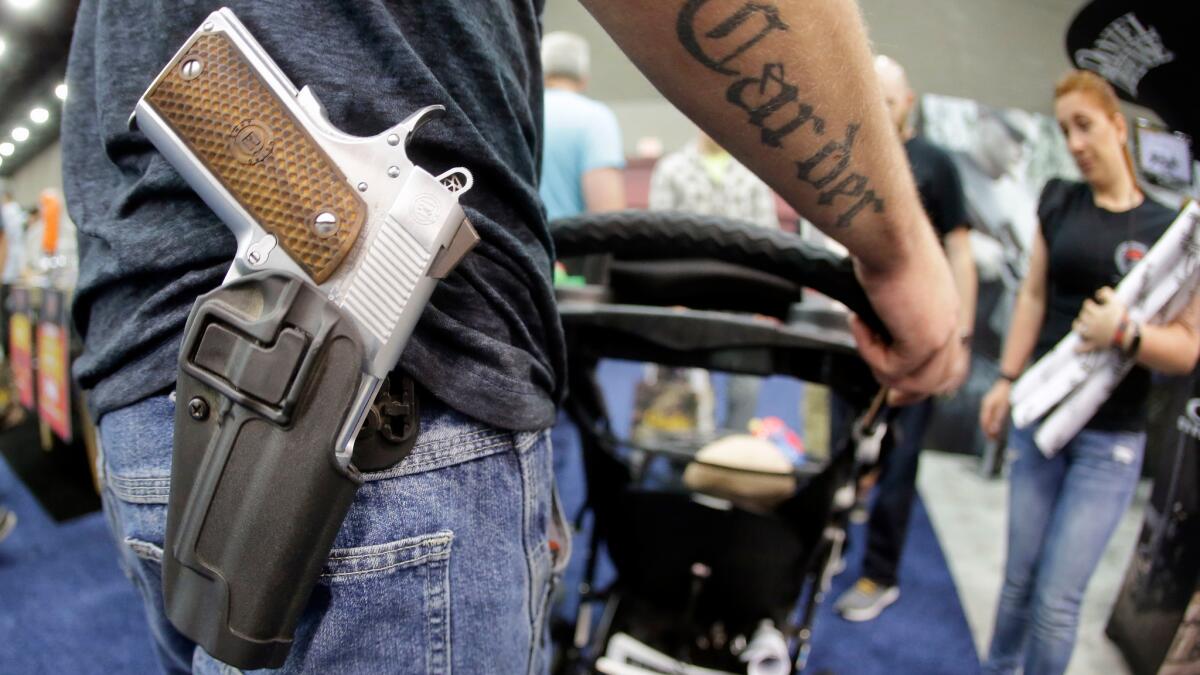Op-Ed: Even in the Wild West, there were rules about carrying concealed weapons

California’s concealed gun carry law — which imposes a series of restrictions on the ability of civilians to carry concealed weapons — was upheld in federal court on June 9, a decision that won predictable plaudits from gun safety advocates and scorn from 2nd Amendment absolutists.
The 9th Circuit Court of Appeals decision in Peruta vs. County of San Diego was notable for two reasons. First, it was consistent with rulings in four other federal appellate courts that supported restrictive state concealed-carry laws, and second, the decision was heavily grounded in a historical analysis of gun laws. Such a reliance on past laws was a key tenet set out by the Supreme Court in its 2008 2nd Amendment ruling in District of Columbia vs. Heller, which for the first time established a personal right to own handguns for self-defense in the home. Though the court’s reading of history in Heller was, to say the least, open to debate, the decision made clear that history would be crucial in determining what gun laws could pass constitutional muster.
Taking its cue from Heller, the 9th Circuit supported its findings with its own intensive historical research. The Peruta decision noted early colonial and state laws that barred or restricted concealed carry, as well as various state court rulings in cases challenging those laws, all of which (with a single exception that was later reversed) upheld state restrictions.
Yet the evidence for limiting gun carry in general and concealed carry in particular is even greater than what was cited in the Peruta decision. Anti-concealed carry laws not only existed but were ubiquitous from the Colonial period through the start of the 20th century. Forty-five states adopted such laws, with most enacted in the early 19th century. They were a reaction to rising crime and interpersonal violence, especially in the South and the so-called Wild West, where anti-gun carry laws were rapidly put in place when cities and towns were established.
The laws often clearly stated what had motivated their passage. For example, New Jersey’s 1686 law imposed concealed carry restrictions by saying that “no person or persons … shall presume privately to wear any pocket pistol … or other unusual or unlawful weapons within this Province” because the practice induced “great Fear and Quarrels.” An 1821 Tennessee law sought to punish anyone “so degrading himself” by carrying prohibited weapons including pistols. Georgia’s 1837 law began: “An Act to guard and protect the citizens of this State, against the unwarrantable and too prevalent use of deadly weapons.” Alabama’s 1839 anti-concealed carry law was titled “An Act to Suppress the Evil Practice of Carrying Weapons Secretly.” Delaware’s 1852 law targeted “all who go armed offensively to the terror of the people.” The point was unmistakable: Anyone who carried a concealed gun was probably up to no good.
Virtually all the evidence explaining the decline in crime in the last two decades indicates that liberalized gun carry laws played no part in it.
These laws persisted. As late as 1981, getting a permit for concealed gun carry was, for civilians, difficult to impossible: 19 states plus the District of Columbia barred concealed carry entirely; 29 states had “may issue” laws like the just-upheld California statute, meaning the government retained discretion as to under what circumstances it would grant permits; only two states had “shall issue” laws, where the state had to issue the applicant a permit unless the individual was barred by a criminal record or similar limitation; one state (Vermont) had no system of permitting.
Then came gun advocates’ long political push to spread concealed carry. Now no states bar concealed carry absolutely (the last to do so , Illinois, was ordered to allow it in a federal court ruling in 2012). Only nine states plus D.C. are “may issue”; 33 states are “shall issue,” and eight states have eliminated permitting entirely.
These laws were almost all enacted before 2008; they weren’t a response to Heller’s finding for a personal right to gun ownership. The primary justification for most of them was fear of crime. However virtually all the evidence explaining the decline in crime in the last two decades indicates that liberalized gun carry laws played no part in it. In fact, the existence of these statutes, coupled with the spread of “stand your ground” self-defense laws, are identified as a cause for a rise in gun deaths compared with states that haven’t adopted such measures. Even in active shooter situations — such as the Orlando massacre — the chaos, uncertainty and fear make it unlikely that an armed amateur could end the carnage.
The Peruta decision stands squarely with an American past where gun laws and gun rights were perfectly compatible. It also reminds us that, as our forebears well knew, civilians carrying concealed weapons in public were more likely to cause mayhem than promote safety.
Robert J. Spitzer is a professor of political science at the State University of New York at Cortland. He is the author of five books on gun policy, most recently, “Guns Across America: Reconciling Gun Rules and Rights.”
Follow the Opinion section on Twitter @latimesopinionand Facebook
More to Read
A cure for the common opinion
Get thought-provoking perspectives with our weekly newsletter.
You may occasionally receive promotional content from the Los Angeles Times.










